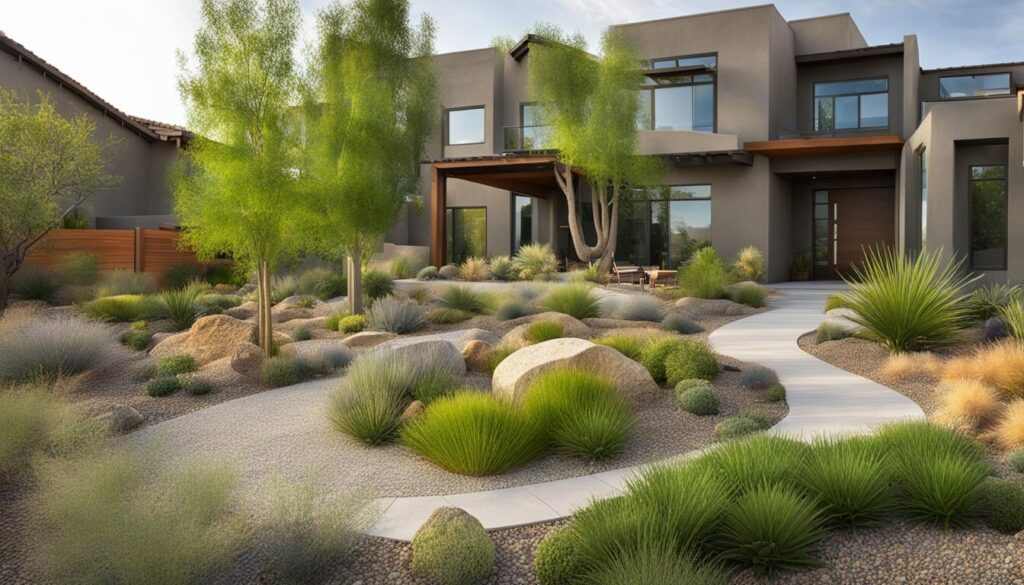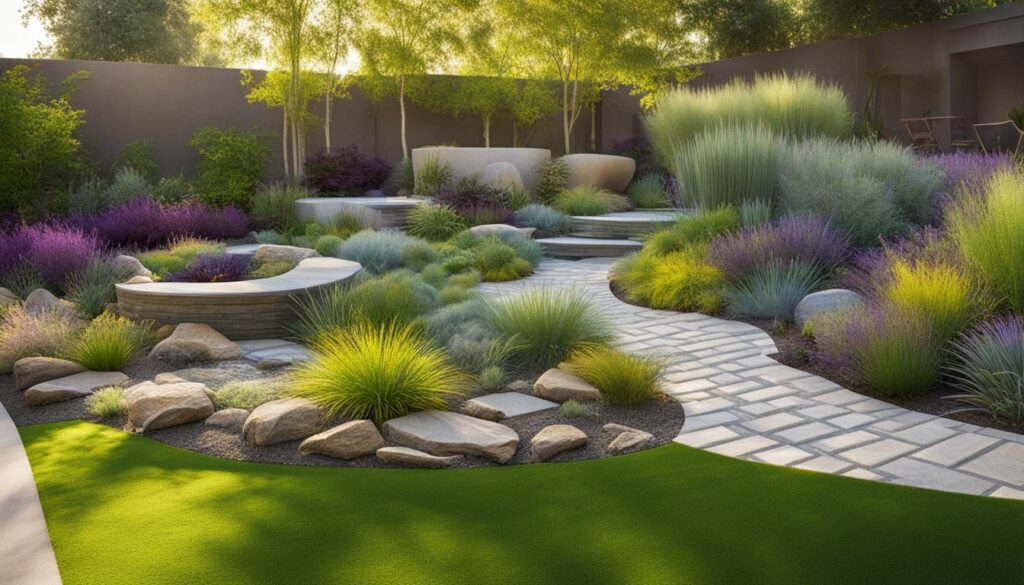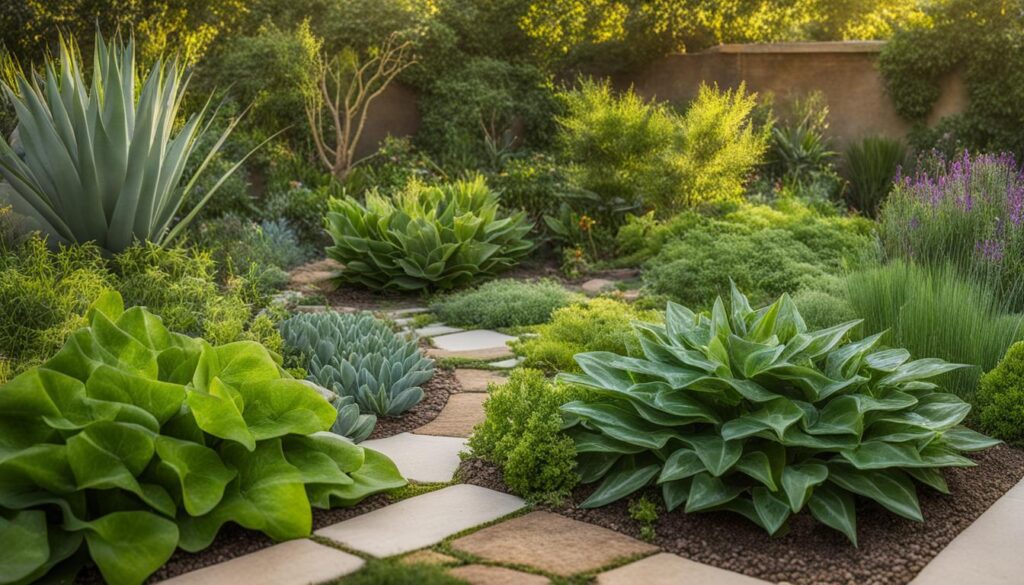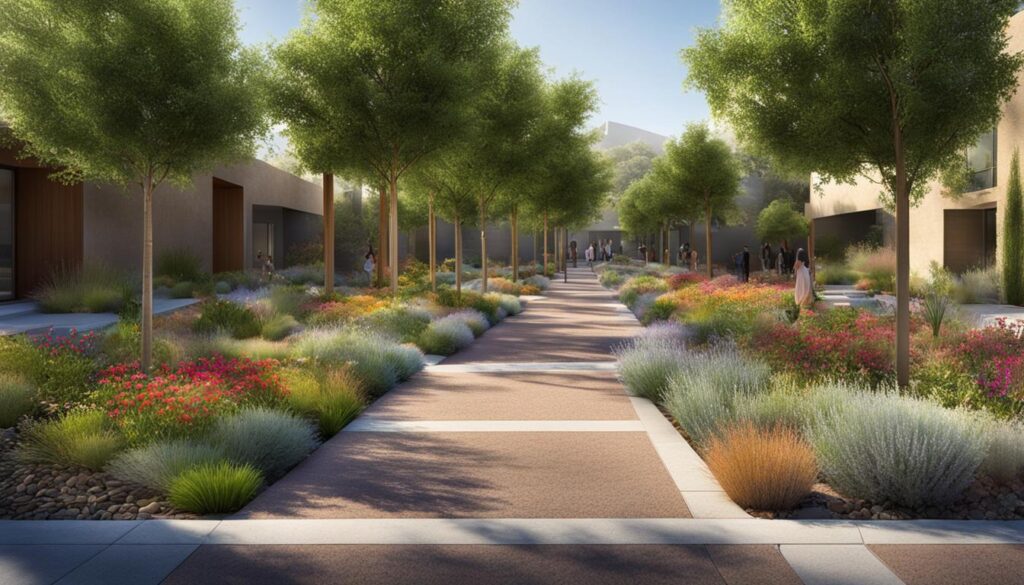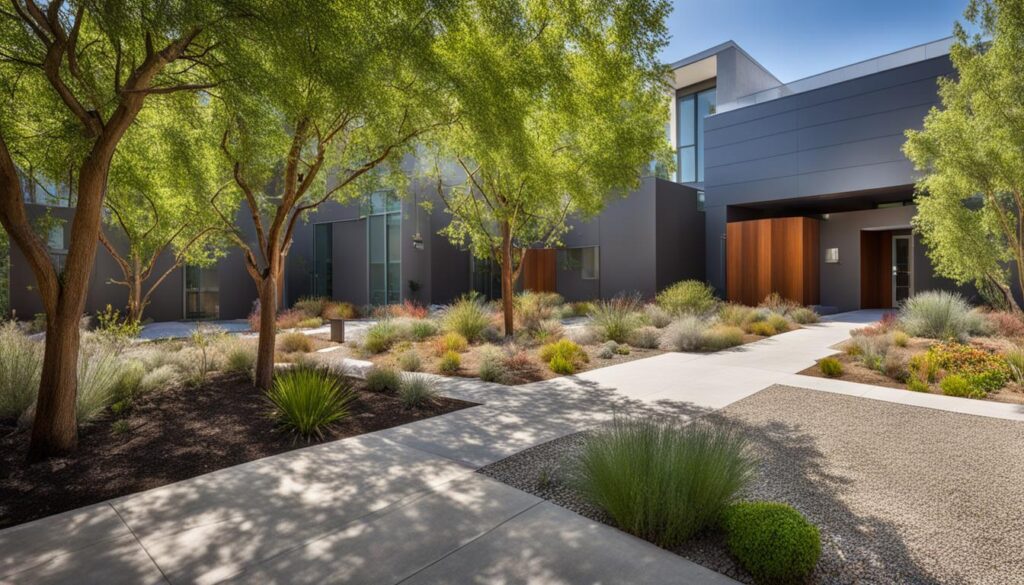Are you concerned about water preservation in urban areas? With increasing water scarcity and the need for sustainable practices, it’s crucial to explore eco-friendly landscaping options. One such solution is urban xeriscaping, which combines water-efficient techniques with beautiful landscape design.
Urban xeriscaping is a landscaping approach that focuses on utilizing native and drought-tolerant plants, reducing water consumption, and minimizing maintenance requirements. By implementing these practices, you can not only create a visually appealing landscape but also contribute to water preservation efforts in your community.
Key Takeaways:
- Urban xeriscaping is an eco-friendly landscaping solution that prioritizes water efficiency.
- By using native and drought-tolerant plants, you can significantly reduce water consumption in your landscape.
- Implementing smart irrigation techniques and utilizing recycled water and graywater can further enhance water conservation.
- Local governments can promote water efficiency in new construction and retrofit existing buildings for sustainable water use.
- By adopting urban xeriscaping practices, you can contribute to water preservation, energy savings, and reduced carbon emissions.
Planning a Comprehensive Water Efficiency Program
When it comes to water conservation, local governments play a crucial role in implementing initiatives that can make a significant impact. One such initiative is the development of a comprehensive water efficiency program. By appointing a water efficiency coordinator and assembling a dedicated water conservation team, communities can take proactive measures to reduce water usage and promote sustainable practices.
A comprehensive water efficiency program involves several key components. It begins with conducting a thorough water audit to assess current consumption patterns and identify areas for improvement. This audit helps to establish a baseline for water usage and sets the stage for implementing targeted retrofits and efficiency measures.
“A comprehensive water efficiency program involves several key components. It begins with conducting a thorough water audit to assess current consumption patterns and identify areas for improvement.”
Water efficiency retrofits are an essential part of the program. This can include installing water-efficient equipment in municipal buildings, such as low-flow toilets and faucets, as well as replacing high water-consuming fixtures. By upgrading infrastructure and implementing these water-saving measures, local governments can significantly reduce water consumption in their facilities and inspire the community to follow suit.
Benefits of a Comprehensive Water Efficiency Program:
- Reduced water usage and associated costs
- Promotion of sustainable practices
- Conservation of precious water resources
- Enhanced public awareness and education
- Positive impact on the environment
A comprehensive water efficiency program is essential for any community committed to sustainable water management. By appointing a water efficiency coordinator, conducting a thorough water audit, and implementing retrofits, local governments can take proactive steps toward conserving water and promoting a more eco-friendly future.
Xeriscape for Water Efficient Landscaping
Xeriscape, or water efficient landscape design, offers a sustainable solution for conserving water in urban areas. By selecting appropriate plant species and implementing smart techniques, xeriscaping can significantly reduce water consumption while creating visually appealing landscapes. Here are some key strategies to consider when implementing xeriscape principles:
1. Choose Native and Drought-Tolerant Plants
Selecting native plants that are well-adapted to the local climate and require minimal water can greatly reduce irrigation needs. Drought-tolerant plants, such as succulents and cacti, are also excellent choices as they can thrive with little to no supplemental watering.
2. Implement Hydro Zoning
Hydro zoning involves grouping plants with similar water requirements together. This allows for more efficient irrigation, as different zones can be watered according to their specific needs. By avoiding overwatering and ensuring plants receive the right amount of water, hydro zoning helps maximize water efficiency.
3. Enhance Water Conservation with Proper Soil Preparation and Mulch
Preparing the soil before planting helps improve its water-holding capacity, reducing the need for frequent irrigation. Adding organic matter, such as compost, can enhance soil moisture retention and provide essential nutrients to plants. Additionally, applying mulch around plants helps regulate soil temperature, minimize evaporation, and suppress weed growth, further conserving water.
Incorporating these xeriscape strategies into your landscape design can significantly reduce water usage while creating vibrant and sustainable outdoor spaces. By harnessing the power of native and drought-tolerant plant species, implementing hydro zoning, and adopting proper soil preparation and mulching techniques, you can contribute to water conservation efforts in your community while enjoying a beautiful and eco-friendly landscape.
Smart Landscape Irrigation
In today’s era of water conservation, smart landscape irrigation techniques have emerged as a crucial solution to reduce water consumption while maintaining healthy and vibrant landscapes. By incorporating efficient irrigation methods, such as drip irrigation and weather-based irrigation control, you can significantly reduce water waste and promote sustainable water usage in your outdoor spaces.
One of the key strategies for smart landscape irrigation is the implementation of drip irrigation systems. Unlike traditional sprinkler systems that distribute water over a wide area, drip irrigation delivers water directly to the root zone of plants, minimizing evaporation and reducing water runoff. This targeted approach not only conserves water but also ensures that plants receive sufficient hydration at their roots, promoting healthier growth and minimizing water-related diseases.
“Drip irrigation is a game-changer when it comes to water efficiency in landscaping. By providing water precisely where it’s needed, we can eliminate wastage and optimize plant health,” says Jane Smith, a leading landscape architect.
Another smart irrigation technique is weather-based irrigation control. By utilizing weather sensors or smart controllers, you can adjust your irrigation schedule based on real-time weather conditions. This intelligent system takes into account factors such as rainfall, temperature, humidity, and evapotranspiration rates to optimize water usage, preventing overwatering during wet periods and ensuring adequate irrigation during dry spells.
The benefits of smart landscape irrigation
- Water conservation: Smart irrigation helps you save significant amounts of water by avoiding wasteful practices and ensuring precise water delivery.
- Cost savings: By reducing water consumption, you can cut down on your water bills, leading to long-term cost savings.
- Environmental sustainability: By conserving water resources, smart irrigation contributes to a more eco-friendly approach to landscaping, reducing the strain on local water supplies and promoting environmental sustainability.
- Plant health: Efficient water delivery through drip irrigation and weather-based control promotes healthier plant growth, minimizing water-related diseases and maximizing the beauty of your landscape.
With smart landscape irrigation techniques like drip irrigation and weather-based irrigation control, you can transform your outdoor spaces into water-efficient, environmentally-friendly havens. By embracing these practices, you not only contribute to water conservation efforts but also create a sustainable landscape that enhances the beauty of your surroundings.
Recycled Water and Graywater Usage
One of the most effective ways to conserve water in urban areas is by utilizing recycled water and graywater for various purposes. Recycled water refers to treated wastewater that has undergone rigorous filtration and disinfection processes to meet specific quality standards. Graywater, on the other hand, is the wastewater generated from domestic activities such as laundry, dishwashing, and bathing. By incorporating these alternative water sources into our daily practices, we can significantly reduce our reliance on potable water for non-potable uses, such as landscape irrigation.
Local governments with existing infrastructure can play a crucial role in promoting the use of recycled water. One common application is the irrigation of municipal parks and landscapes. By implementing rainwater catchment cisterns, which collect and store rainwater, we can further augment the available water supply for irrigation purposes. These solutions not only conserve water but also reduce the strain on the potable water system, ensuring its availability for essential needs.
An innovative approach to utilizing graywater is through subsurface irrigation in municipal building landscapes. By channeling graywater to designated irrigation areas, such as through specially designed drip irrigation systems, we can efficiently provide water directly to plant roots, minimizing waste and maximizing efficiency. This method not only conserves water but also reduces urban runoff and helps replenish groundwater resources.
Benefits of Recycled Water and Graywater Usage:
- Conserves potable water by utilizing alternative sources
- Reduces strain on existing water supplies
- Minimizes water waste and promotes efficiency
- Reduces the carbon footprint associated with water treatment and distribution
By embracing the use of recycled water and graywater, local governments can make significant strides in sustainable water management. These practices not only preserve water resources but also contribute to the overall resilience and environmental well-being of urban communities.
Water Efficiency for New Construction
When it comes to new construction projects, incorporating water efficiency measures is essential to promote sustainability and reduce water consumption. By adopting green building requirements and utilizing recycled water infrastructure, local governments can contribute to long-term water conservation efforts.
One key aspect of water efficiency in new construction is the implementation of green building requirements. These requirements encompass various strategies and technologies that aim to minimize water usage throughout the life cycle of a building. From efficient plumbing fixtures to rainwater harvesting systems, these requirements ensure that new constructions are designed with water conservation in mind.
“Green building requirements play a crucial role in promoting sustainable development. By integrating water-efficient technologies into new constructions, we can create buildings that are not only environmentally friendly but also economically efficient.”
Furthermore, promoting the use of recycled water infrastructure can significantly reduce the dependency on potable water for non-potable purposes in new buildings. By incorporating dual plumbing systems and reclaimed water distribution systems, local governments can enhance the availability and accessibility of recycled water for irrigation, flushing toilets, and other non-potable uses.
Promoting Water Efficiency in New Construction:
- Adopt green building requirements to ensure water efficiency measures are incorporated in new constructions.
- Design buildings with efficient plumbing fixtures and rainwater harvesting systems.
- Implement dual plumbing systems and reclaimed water distribution infrastructure.
- Educate contractors and developers about the benefits and importance of water efficiency in new construction.
By prioritizing water efficiency in new construction, local governments can contribute to a more sustainable future while also saving costs on water consumption. These proactive measures not only benefit the environment but also promote the overall well-being of communities.
How Can Urban Xeriscaping Solutions Contribute to Sustainable Water Management?
Urban xeriscaping solutions can contribute to sustainable water management with xeriscaping by reducing the need for excessive irrigation and promoting the use of native, drought-resistant plants. This method decreases water consumption and helps maintain a healthy balance of water resources in urban environments.
How Can Xeriscaping Help Conserve Water in Urban Areas?
Xeriscaping is an effective method for improving soil water retention in urban areas, ultimately conserving water. By utilizing drought-resistant plants and mulch, xeriscaping reduces the need for frequent watering, leading to significant water savings in urban landscapes.
Conclusion
Urban xeriscaping solutions offer practical and effective methods for water conservation in urban areas. By implementing comprehensive water efficiency programs, adopting xeriscape principles, utilizing smart irrigation technologies, and promoting the use of recycled water, you can significantly reduce water consumption and create eco-friendly landscapes. These efforts not only help conserve water but also contribute to energy savings, reduced carbon emissions, and the overall sustainability of urban environments.
By embracing urban xeriscaping, you can make a positive impact on water conservation and create a more environmentally friendly landscape. Incorporating native and drought-tolerant plants, hydro zoning techniques, and proper soil preparation can greatly reduce water consumption in landscaping. Additionally, smart landscape irrigation methods like drip irrigation and weather-based control can optimize water usage, prevent runoff, and save you money in the long run.
Furthermore, by utilizing recycled water for irrigation purposes and implementing graywater systems, you can maximize water conservation efforts. Municipal parks, landscapes, and even new construction projects can benefit from the use of recycled water and rainwater catchment cisterns. By expanding recycled water infrastructure and adhering to green building requirements, local governments can lead the way in creating sustainable communities.
With your commitment to urban xeriscaping and water conservation, you can play a vital role in preserving our precious water resources. By making eco-friendly choices in landscaping and incorporating water-efficient practices, you are contributing to a greener and more sustainable future for your community. Together, we can create a harmonious balance between urban development and environmental preservation.






